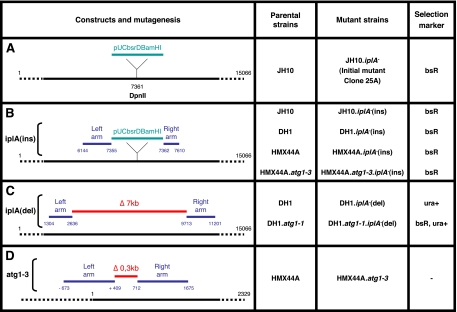Figure 1.
iplA and atg1 constructs and mutants in distinct Dictyostelium strains. (A) Localization of the pUCbsrDBamHI insertion in the iplA gene (accession no. AJ277590) in the initial JH10 mutant clone 25A. Plasmid rescue and identification of flanking sequences on each side of pUCbsrDBamHI showed its insertion in the DpnII site at position 7361 of the iplA gene. pUCbsrDBamHI contained a blasticidin resistance marker. (B) Rescued plasmid, called iplA(ins) vector, used to mutagenize the iplA gene by homologous recombination, and its insertion point. The right and left arms flanking pUCbsrDBamHI were used to target the iplA gene, leading to its disruption by insertion. Left and right arms correspond to positions 6144-7355 and 7362-7610 of the iplA gene, respectively. Compared with the published AX4 genome sequence, there is a small deletion of six nucleotides upstream of the insertion, due either to a sequence difference between strains, or to an event occurring during preparation of the construct (which we nevertheless consider an insertion construct). This plasmid was used to obtain simple iplA− mutants in JH10, DH1, and HMX44A and by insertion in HMX44A.atg1-3 (see D), a double atg1− iplA− mutant in HMX44A. (C) Construct, called iplA(del) vector, used to introduce a deletion in the iplA gene. Left and right arms amplified by PCR correspond to positions 1304-2636 and 9713-11201 of the iplA gene, respectively, enabling to delete ∼7 kb of the iplA gene. This vector, which contained an ura selection marker, was used to obtain in DH1 a simple iplA− and a double atg1− iplA− mutant. (D) Construct, called atg1-3 vector, used to introduce a deletion in the atg1 gene. Left and right arms amplified by PCR correspond to the positions −673 to +409 and 712-1675 of the atg1 gene (accession no. AY191011), respectively, resulting in deletion of ∼0.3 kb of the atg1 gene. The floxed blasticidin resistance cassette in the insert was removed using the Cre expression vector pDEX-NLS-Cre (Faix et al., 2004). The resulting HMX44A.atg1-3 cells were mutated for the atg1 gene and sensitive to blasticidin. They were used in (B) to obtain a double atg1− iplA− mutant.

